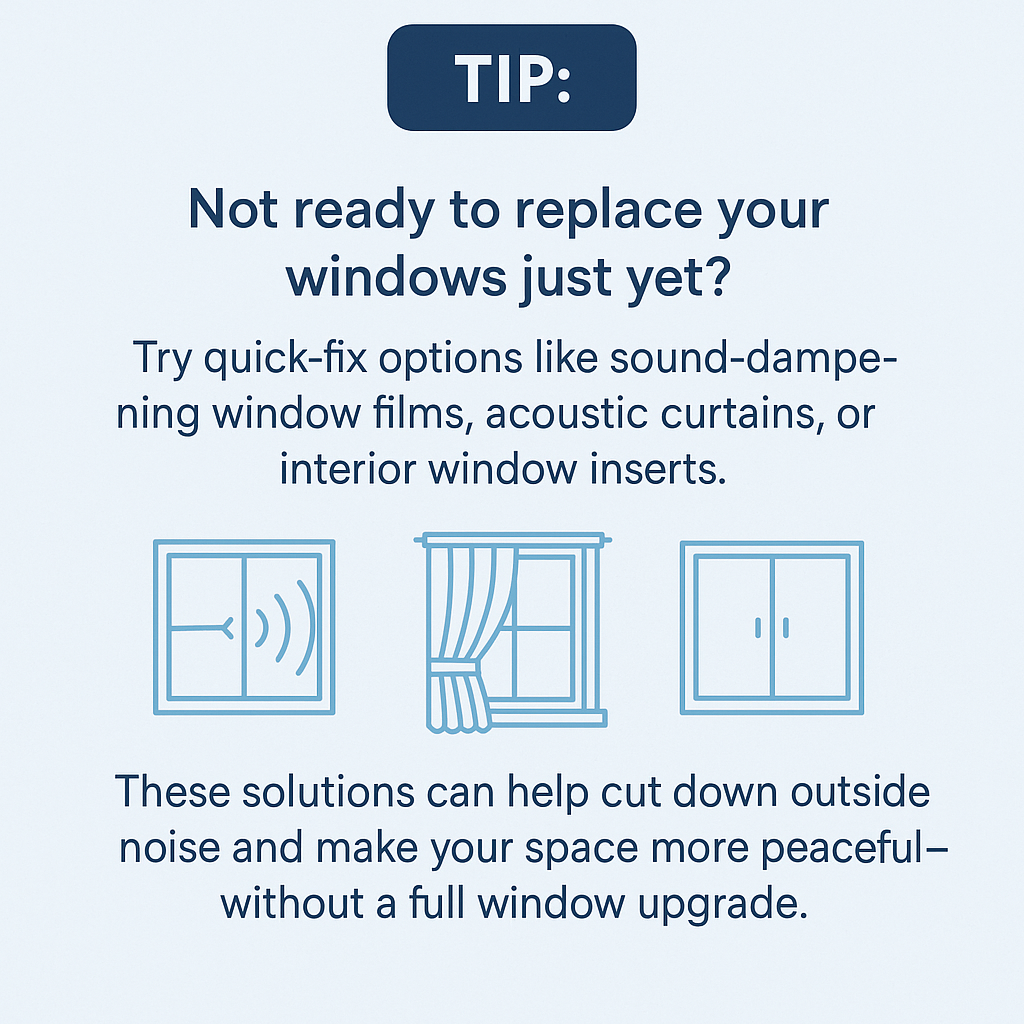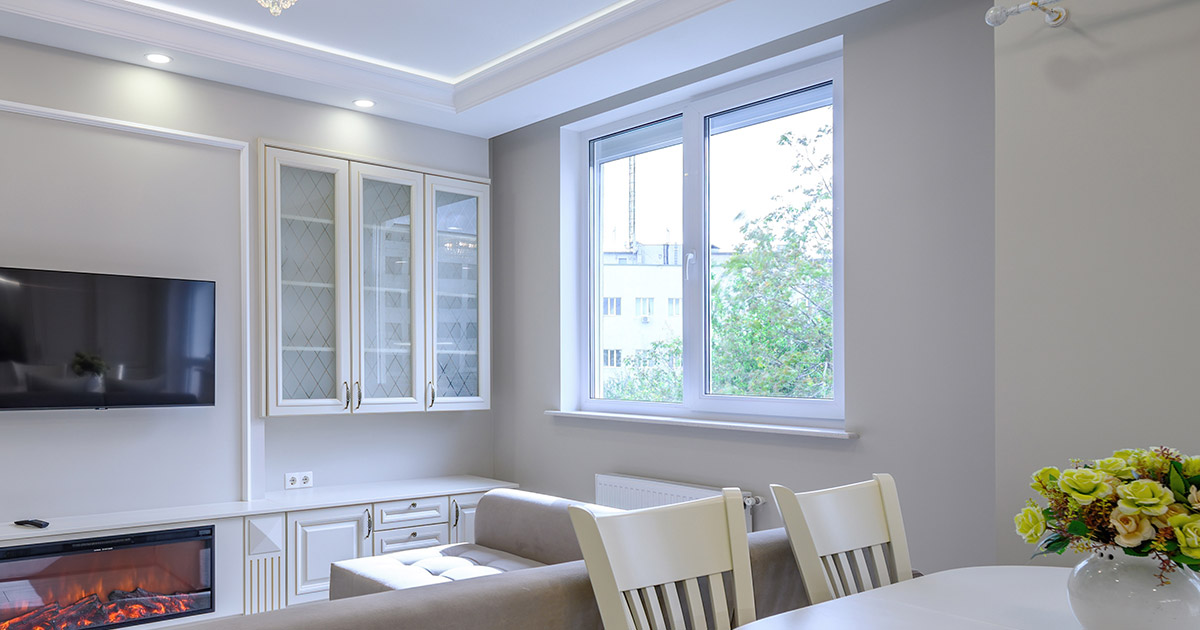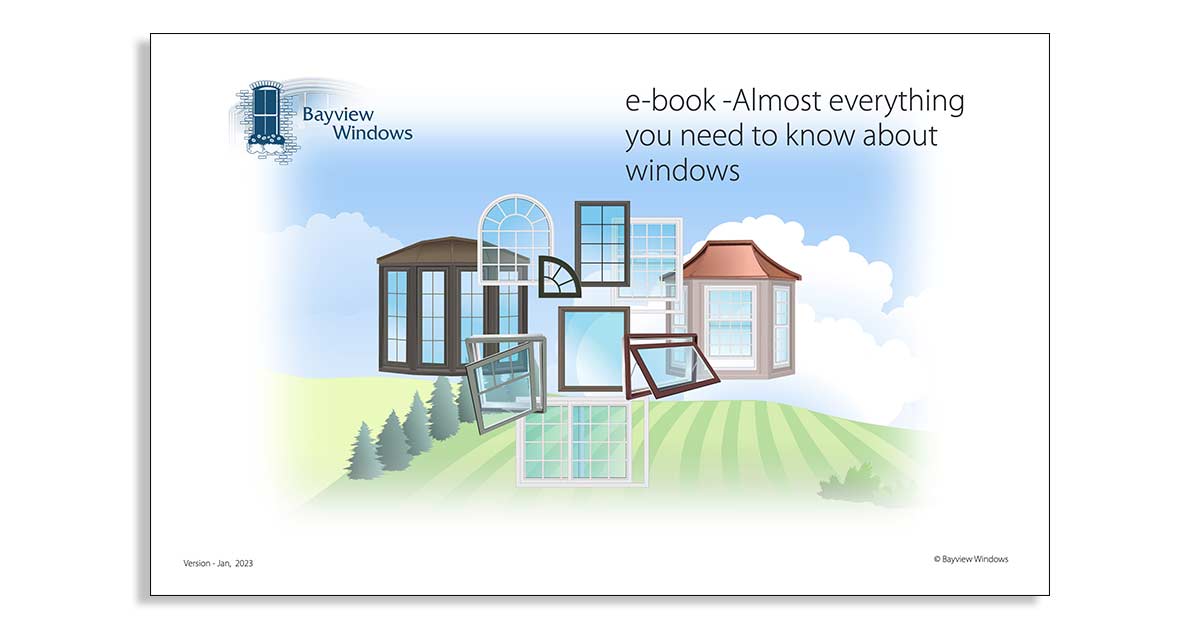Insights > Category > Posted: 2025-Apr-22, Updated: 2025-Apr-22
Window Options
Reducing Outside Noise

Common pathways for noise intrusion
Even the most advanced windows can’t completely block outdoor noise — but they can significantly reduce it. And even if your windows could eliminate 100% of sound, noise could still find its way in through walls, the attic, vents, and other parts of your home’s structure.
Because windows are often the weakest point in your home’s acoustic barrier, they’re a natural starting place for homeowners looking to reduce outside noise. Old single-pane windows are often the weakest link. Simply upgrading to double-pane windows can make a noticeable difference.
What affects sound entering your home?
Where you live
Homes near traffic, trains, or airports get more outside noise.
Insulation
Thin walls or poor insulation let more sound through.
Window size and number
Bigger or more windows can let in more noise.
Window quality
Double or triple-pane windows block sound better than old single-pane ones.
Installation and frame
Good installation and solid frames help keep noise out.
The science behind sound transmission
Frequency (Hz)
Measures the pitch of sound. Higher frequencies are easier to block than lower ones. Frequency, measured in Hertz (Hz), refers to how many wave cycles occur per second. Humans hear from 20 Hz to 20,000 Hz, while dogs can hear up to 65,000 Hz. Higher frequencies mean higher-pitched sounds.
Decibels (dB)
This unit measures the amplitude pressure (loudness) of sound. This sound pressure scale begins at 0 decibels (the threshold for audibility for humans). The higher the decibels, the louder the sound.
Sound transmission
Sound transmission is how sound waves travel through air, water, or solid materials. It's measured in decibels (loudness) and hertz (pitch).
Material stiffness
Stiffness refers to how elastic a material is. Sound travels faster through stiffer materials (like steel) and slower through less stiff materials (like foam), which can absorb and dampen sound energy.
Material density (mass)
Denser materials (with more mass per volume) can slow down sound. However, stiffness usually has a greater effect on sound speed than density alone.
Sound damping
Damping refers to any technique used to reduce sound transfer between spaces. Window makers use methods like laminated glass or insulating spacers to minimize sound.
Sound absorption
This is how much sound energy is lost as it passes through a material. For windows, it’s the percentage of sound that doesn’t enter your home.
Soundproofing
Soundproofing blocks sound from entering or leaving a space. It involves methods like adding barriers, increasing distance, or using sound-dampening materials. True soundproof windows require every part—from glass to frame—to be optimised for sound reduction.
Sound leakage
Sound leaks occur wherever outside noise enters a home — through old windows, poor seals, vents, cracks, or under-insulated areas.
Window sound ratings:
STC and OITC
To compare windows for sound performance, look at these two ratings:
STC (Sound Transmission Class)
Rates how well a window blocks higher-frequency indoor sounds like voices or TV. Typically ranges from 20 to 60+ (no specific units, just a rating). Test Standard: ASTM E90 / ASTM E413.
OITC (Outdoor/Indoor Transmission Class)
Measures performance against lower-frequency outdoor noise, such as trucks or aircraft. Typically ranges from 20 to 40+ (no specific units, just a rating). Test Standard: ASTM E1332.
| Average STC Rating | Barrier Material |
|---|---|
| 30-36 | 2 x 4 wood stud wall with drywall (2 sides) |
| 15-21 | Single-pane window |
| 25-27 | Dual-pane window |
| 25-31 | Triple-pane window |
| 35 | Single Laminated glass window |
| 35-38 | A Window insert - a second window is added behind an existing window. |
| 45 or more | A specialised soundproof window - designed specifically to filter out sound. |
Tip 1: The higher the STC (Sound Transmission Class) or OITC (Outdoor–Indoor Transmission Class) rating, the better a window is at reducing sound.
Tip 2: Window quotes don’t usually include STC or OITC sound ratings, but some manufacturers can provide this info if asked. If sound reduction is important to you, be sure to request the STC or OITC ratings when discussing your window options.
Standard vs. noise-reducing vs. soundproof windows
| Type | Typical Rating | What You Get |
|---|---|---|
| Standard | STC 25–27 | Basic double-pane insulation |
| Noise-reducing | STC 30–35+ | Laminated or asymmetrical glass |
| Soundproof (high-end) | STC 45+ | Specialty glass and framing systems |
Tip: If your home's exterior walls have an STC rating of 30–35, investing in soundproof windows with an STC of 50 may not be worth it — sound will still pass through the walls. For balanced sound reduction, match window STC ratings more closely with your wall performance.
Glass technologies that help block noise
To reduce sound transmission, window manufacturers use a few strategies:
Laminated glass
Laminated glass is made by bonding two glass layers with a strong plastic layer in between. Even if it breaks, it stays together. North Star Windows offers a version with 6mm laminated glass on the outside and 3mm regular glass on the inside. This setup changes how sound travels through the glass, reducing noise. It also adds security because the glass holds together when shattered.
Triple-pane glass
Triple-pane windows can block more sound than double-pane windows — sometimes improving noise reduction by up to 7 STC points, especially if the panes are spaced well. They work by adding weight and increasing the air space between the layers, which helps block sound.
Dissimilar glass panes
Some windows use two glass panes of different thicknesses — for example, one 1/8 inch and the other 1/4 inch. Because each thickness blocks different sound frequencies, the window can reduce a wider range of noises.
Frame and sash material
The materials used for the window frame and sash affect how well a window blocks sound. Vinyl or wood is better at reducing noise than aluminium, which carries sound more easily. Some companies add foam or use special chambers in the frames to help reduce noise. Not sure which works better? Compare their STC ratings.
Type of window
The window style also affects how much sound gets through. Picture windows block the most noise, followed by casement, hung, sliding, and awning windows. To know for sure, check the STC rating for each type.
Specialised soundproofing windows
Soundproof windows are made specifically to block as much noise as possible. They’re more expensive because every part is designed for sound reduction. Soundproof windows are not typically offered by most window replacement companies. For extreme noise issues you may need to hire an acoustic consultant
Tip: If you're in a typical residential setting and want a meaningful reduction in noise without the high cost of specialised windows, high-STC laminated or triple-pane windows from reputable residential window brands are often a great compromise.
Best window types for noise control
Casement windows
Close tightly, forming a strong acoustic seal.
Awning windows
Similar to casements and effective in smaller spaces.
Fixed/picture windows
No moving parts means fewer gaps — great for blocking sound.
Tip: 1. Wood, 2. Vinyl, and 3. fibreglass frames typically insulate better than 4. aluminium (sound insulation best to least effective), helping reduce both heat loss and sound transmission for a quieter, more energy-efficient home.
Energy-efficiency and sound-damping solutions
Solutions that reduce sound transmission through a window change its energy-saving properties since the window is optimised for sound reduction, not energy efficiency. When you are shopping for new windows, if energy efficiency is important to you, be sure to tell your window consultant that you are looking for an energy-efficient and sound-reducing solution.
Beyond the window: A whole-home strategy
While replacing your windows can drastically improve indoor sound levels, true noise reduction often requires a broader approach:
- Upgrading wall insulation
- Sealing gaps and penetrations
- Adding soundproof doors or acoustic panels
Aftermarket soundproofing solutions
If you are not yet in the market for replacement windows, there are some quick-fix solutions that may offer some relief from external sound.

Sound-dampening window films
Aftermarket film laminates can filter out as much as 5 decibels of sound, according to some manufacturers. Typically made with 3 layers, the centre one does all of the sound blocking. The two layers on either side of it are made from polymer and support the product’s application and aesthetics. These films can be installed on virtually any type of window or glass.
Curtains & blinds
While window coverings alone can’t make your home soundproof, they can absorb noise coming through the window and help reduce exterior noise. Look for a honeycomb design, which can insulate your windows from the heat and cold as well. There are plenty of companies and solutions out there to meet your acoustic and aesthetic needs.
Window inserts
Inserts can be installed behind an existing window, adding dead, sound-reducing air between the principal window and the new interior insert, which can have an STC rating of 38 up to a 95% noise reduction, depending on the size of the window opening and type of noise.
These windows create large airspaces between the set of 2 windows, which kills noise by disrupting the sound waves. Note: These windows are typically made as non-operational and will prevent access to operational windows.
Summary
Whether you're dealing with street noise, construction, or just want a more peaceful space, selecting the right window design can make a big difference. The key is understanding your environment and working with experienced professionals to find the best combination of features for noise reduction and energy efficiency.
Related stories
Need more information?
Have questions about noise reduction and your new replacement windows? We're here to help! Whether you're looking to block traffic noise, reduce outdoor chatter, or just enjoy a quieter home, we’d be happy to walk you through your options and answer any questions you have.
20 Best Value Tips
Free E-Book
Reducing Outside Noise
E-BOOK GUIDE
INFOGRAPHIC
INFOGRAPHIC
Fogged Window Panes
Signs & Considerations
Builders vs Premium Grade
Full-Frame vs Pocket
You've Got Options
Basement Windows
The Art of Window Shopping
Top Considerations
Custom Window Shapes
Window Types
INFOGRAPHIC
Right For Your Home
Single-Glaze vs Multi-Glaze
INFOGRAPHIC
Window Interior
Window Exterior
Best Replacement Windows
Choosing a Material
Reducing Outside Noise
Window Grills
Operational Windows
The Colour Process
Weatherstripping
Window Jambs
Window Flashing
Window Spacers
Trim, Capping, Cladding...
Self-Cleaning Windows
Sash vs No Sash Windows
Bay and Bow Windows
Slider Configurations
Slider Pros & Cons
Awning Pros & Cons
Casement Pros & Cons
Hung Pros & Cons
Window Energy Efficiency
The basics
30 Common Myths
Do's and Don'ts
Winter Screen Protection






